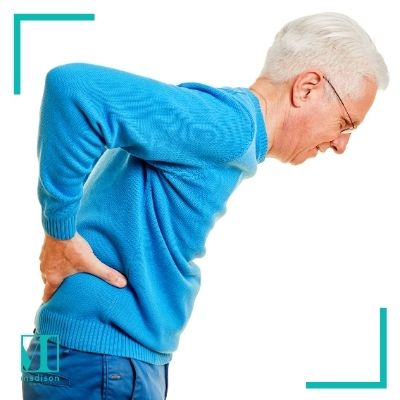
Arthritis means inflamed joints. It refers to a range of conditions that involve pain, stiffness and inflammation in the joints.
Arthritis comes in many types. The most common type of Arthritis is Osteoarthritis. This is a problem of wear and tear due to excessive use over the years. With old injuries in the affected joints contributing too. These issues cause increased pressure in the joints, which leads to friction, damage, and swelling.
We should note that cracking your knuckles DOES NOT give you arthritis, but it could have other affects!
Osteoarthritis is a chronic and progressive condition. It mostly affects the weight-bearing joints such as the spine (more frequent low back and neck), knees and hips. Other areas that can become affected too. Like the base of the thumb, the ends of the fingers and the big toes commonly.
In Australia, 1 in 11 people (that is 2.2 million people, or nearly 10% of the population) have osteoarthritis. This number increases to 3 in every 5 if you are female.
1 in 10 people with osteoarthritis are aged 45 years and over.
Most cases of arthritis are ‘mild’, and most of those people coped with the pain. Most people were also 45 years old or more. This means that daily lifestyle can be increasingly affected as we age.
There is no cure for arthritis. However there are many ways to get some joint pain relief and make life more comfortable. Thereby managing symptoms, and increasing joint flexibility to improve your quality of life.
What can you do about aching joints?
Treatment/prevention consists of non-pharmacological interventions. Including a change in life style (weight management and healthy diet), maintaining activity levels, using heat with massage therapy, manual therapy, and walking aids. Pharmacological treatment includes herbal therapies, vitamins, supplements and medications.
As a last resort surgical interventions such as joint replacement can be considered.
Weight management and healthy diet.
Maintain your ideal weight to avoid unnecessary wear on the joints. Being overweight has a significant impact on the musculoskeletal system. This increases the risk of developing osteoarthritis. Weight loss improves symptoms, and slows down the disease progression. Eating healthy and reducing weight is ideal in order to improve both pain and function of the body/joints. Discuss with your dietician about weight loss management.
Exercise
Keep a good balance of adequate rest with sensible exercise. This is to improve pain and function. Benefits are possible regardless of your age, structural disease severity, functional status or pain levels. Exercise has also been found to be beneficial for other specific health issues and overall health. It is recommended to do some walking, muscle-strengthening exercise and swimming. It may be appropriate to offer stationary cycling and/or certain types of yoga.
Exercise dosage can vary in frequency, intensity and duration depending on the person. However, if you stop any exercise or activity this may increase the pain.
Heat with massage therapy
It is usual to feel more comfortable when the weather is warm. A hot-water bottle, warm bath or electric blanket can soothe the pain and stiffness. Avoid getting too cold. It may be appropriate to offer a short course of massage therapy. This can be most helpful in improving muscle tone, and reducing soft tissue inflammation. As well as improving soft tissue repair, increasing circulation, and inducing relaxation.
Book a targeted remedial massage with our team today!
Manual therapy including chiropractic care
Manual therapy comprises a number of techniques. The most common being manipulation and mobilisation, as well as specific chiropractic adjustments. This refers to skilled hands-on techniques where accurately determined and specifically directed manual force is applied to the joints. The aims of specific adjustments include: reducing pain, increasing range of motion and mobility, facilitating movement, improving function.
Talk to our chiro team to see how we can help.
Walking aids
Shoe inserts, good footwear and a walking stick can help painful knees, hips and feet. We have some options for things like heel lifts and can advise on other aspects of mobility aids. However if you need custom foot wear talk to a Gold Coast Podiatrist near you.
Other options for treatment
Including herbal therapies, supplements for joint pain, medications, NSAIDs – Non-Steroidal Anti-inflammatory Drugs.
Consult your doctor to find the right medical treatment for you. Topical cream/gel (NSAIDs. Capsaicin) can penetrate the skin, enter tissues or joints. This can reduce processes that are causing pain in the tissues. Drug levels in the blood with topical NSAIDs are much lower than with the same drug taken by mouth.
Some painkillers can be effective in mild cases. If pain continues, doctors may recommend a group of drugs called non-steroidal anti-inflammatory drugs (NSAIDs). These should be taken with food. These drugs may have side effects in the stomach or intestine. Therefore inform your doctor if you have had a peptic ulcer or gut indigestion.
There are many different modalities of treatment called intra-articular injection. These are for joints (knee, elbow, hip) and epidural spinal injection (spine). These injections use steroids, hyaluronic acid, PRP (plasma rich platelet) and more.
Some people may find over-the-counter remedies can bring relief. These include glucosamine, chondroitin, Curcumin (also known as turmeric), omega- 3 fatty acid and other vitamins for joints.
We stock some topical relief products and supplements that may help with symptom relief, so talk to your Wellness Director to see how we can help.
Surgical intervention
Surgery is recommended when all other treatment methods fail or not sufficiently relieving the pain. Surgery can give excellent results with relief of severe pain for most joints (joint replacement). Spinal decompression surgery separates nerve roots from bone spurs and other tissues may pressing on them. The approach of these surgeries is by minimal invasive surgery or with open procedures. Talk with your GP about these options.
How we can help you with joint pain and arthritis right here on the Gold Coast
Arthritis is a painful and often chronic and progressive condition that affects a great many Gold Coast residents every day. The Madison Healthstyle team is here to help in many ways, and to provide co-managed support where recommended.
Our Madison Method of assessment and collaborative care highlights where your movement and function is from the start. This provides a clear map of care options designed specifically for you to get maximum results.
Your next step toward moving better could be as simple as booking an assessment with us today – find a location near you HERE.
References:
2-https://www.mayoclinic.org/diseases-conditions/arthritis/in-depth/arthritis/art-20047971
3-https://www1.racgp.org.au/ajgp/2020/may/national-osteoarthritis-strategy
4-https://www.hopkinsmedicine.org/health/conditions-and-diseases/spinal-arthritis
5 – https://www.health.harvard.edu/pain/does-knuckle-cracking-cause-arthritis


